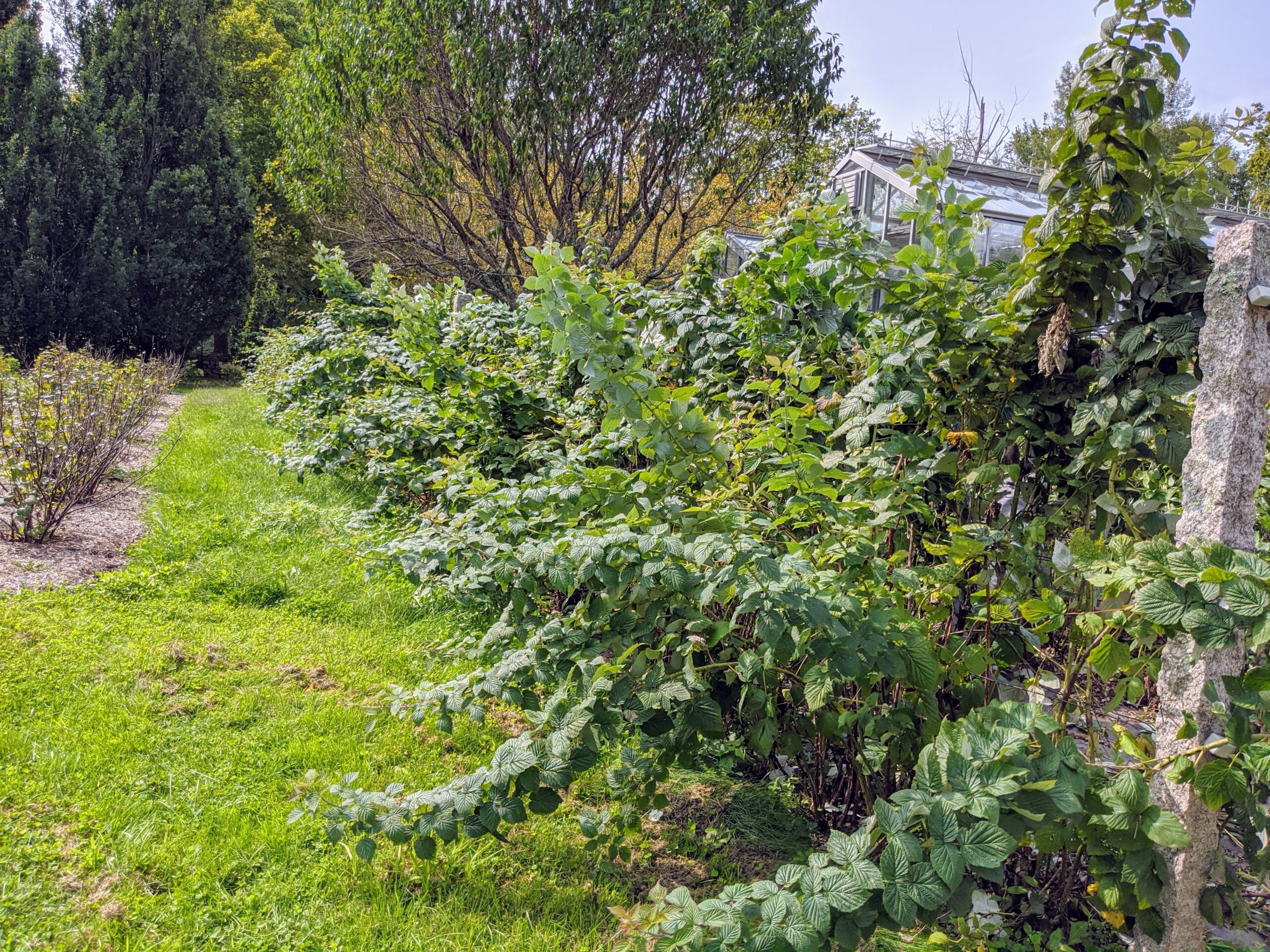Growing your own berries is a rewarding experience, and raspberries, with their sweet and tangy flavor, are a garden favorite for many. From vibrant red raspberries to golden and black varieties, these fruits are delicious eaten fresh and versatile enough for jams, desserts, and juices. To ensure a plentiful harvest year after year, proper care for your raspberry bushes is essential. This guide will walk you through the key steps in raspberry bush maintenance, focusing on post-harvest care to set your plants up for success in the coming season. We’ll cover everything from pruning techniques to supporting growth, ensuring your raspberry patch remains healthy and productive.
Raspberry bushes, like those thriving beside the greenhouse, require seasonal attention to maximize fruit production and maintain plant health. Regular care, especially after the berry picking season, is crucial for encouraging strong growth and preventing diseases.
Understanding Raspberry Bush Types and Growth Habits
Before diving into care techniques, it’s helpful to understand the basics of raspberry bush growth. Raspberries are perennials, meaning their roots live for many years. However, their canes (stems) are biennial. This means each cane lives for two years:
- Year One Canes (Primocanes): These new, green canes grow vegetatively in their first year.
- Year Two Canes (Floricanes): These are the mature, often brownish canes that produce fruit in their second year and then die.
Knowing this life cycle is key to effective pruning and care. There are also two main types of raspberries based on fruiting habits:
- Summer-Bearing Raspberries: These produce one large crop of fruit, typically in June or July, on floricanes (second-year canes). The original article focuses on this type.
- Everbearing (or Fall-Bearing) Raspberries: These produce two crops: a smaller crop in the fall on primocanes (first-year canes) and a larger crop the following summer on the same canes (now floricanes).
The care practices outlined below are primarily for summer-bearing raspberries, but many principles apply to everbearing types as well.
During the peak of summer, healthy raspberry bushes are laden with fruit. Understanding their growth cycle is essential for providing the right care at each stage.
Post-Harvest Pruning: Setting the Stage for Next Season
Post-harvest pruning, typically done in late summer or early fall after you’ve finished picking berries, is arguably the most important care task for raspberry bushes. Here’s why and how to do it:
Why Prune?
- Increased Fruit Production: Pruning encourages new, vigorous growth, leading to a larger and better quality berry yield in the following season.
- Disease and Pest Control: Removing old and weak canes improves air circulation, reducing humidity and the risk of fungal diseases. It also eliminates potential overwintering sites for pests and diseases.
- Bush Health and Vigor: Pruning redirects the plant’s energy into producing strong new canes instead of supporting unproductive old growth.
How to Prune Summer-Bearing Raspberries:
-
Remove Floricanes (Old Canes): After fruiting, floricanes will not produce berries again. Identify these canes – they are typically brownish, thicker, and may show signs of drying out. Cut these canes all the way down to ground level using loppers or pruning shears.
Old raspberry canes, those that have already produced fruit and are brown in color, should be pruned back to the ground to encourage new growth.
-
Thin Primocanes (New Canes): Select the strongest, healthiest primocanes to keep. Thin out weak, spindly, or crowded primocanes. Aim for about 4-6 strong canes per linear foot of row. This spacing allows for good air circulation and sunlight penetration. Also, remove any suckers that are growing outside your desired row width (about 12-18 inches wide base).
Keeping the base of raspberry bushes within a controlled footprint by pruning out suckers ensures optimal growth and resource allocation.
-
Remove Weak, Damaged, or Diseased Canes: Regardless of age, cut out any canes that are weak, damaged, or show signs of disease or insect infestation.
Removing weak, diseased, or damaged canes is crucial for preventing the spread of problems and promoting overall plant health.
Tools for Pruning:
- Loppers: For cutting thicker, older canes at the base.
- Pruning Shears (Hand Pruners): For thinner canes and more precise cuts.
- Gloves: To protect your hands from thorns.
Supporting Raspberry Bush Growth
Raspberry bushes can become quite tall and their canes can bend or break under the weight of fruit or in windy conditions. Providing support is beneficial:
-
Trellising Systems: Wire trellises are a common and effective way to support raspberries. Run wires horizontally along posts, creating levels to guide and support the canes as they grow. You can use two or three wires at different heights (e.g., 2, 3, and 4 feet above ground).
A wire trellising system provides essential support for raspberry canes, preventing drooping and breakage, especially when laden with fruit.
-
Stakes or Posts: Individual stakes or posts can also be used to support clumps of canes, especially for smaller plantings.
Other Essential Raspberry Bush Care Practices
Beyond pruning and support, other care tasks contribute to healthy and productive raspberry bushes:
-
Watering: Raspberries need consistent moisture, especially during fruit development. Water deeply during dry periods, aiming for about 1-2 inches of water per week.
-
Fertilizing: Apply a balanced fertilizer in early spring to provide nutrients for new growth. A soil test can help determine specific nutrient needs. Avoid over-fertilizing with nitrogen, which can lead to excessive leafy growth at the expense of fruit.
-
Weeding: Keep the area around your raspberry bushes free of weeds to reduce competition for water and nutrients and improve air circulation. Mulching with straw, wood chips, or weed cloth can help suppress weeds and retain soil moisture.
Employing weed cloth or mulch around raspberry bushes helps to suppress weeds, conserve soil moisture, and reduce the need for manual weeding.
-
Pest and Disease Management: Monitor your raspberry bushes regularly for signs of pests or diseases. Common raspberry pests include aphids, spider mites, and cane borers. Diseases can include fungal issues like gray mold and cane blight. Address any problems promptly with appropriate organic or chemical controls as needed.
Preparing for Winter
While post-harvest pruning is a major step in fall care, consider these winter preparations as well:
- Winter Pruning (for Everbearing Raspberries): For everbearing types, you may choose to prune back the tips of primocanes in late winter or early spring to encourage a larger summer crop on the lower portions of the canes.
- Mulching: Apply a layer of mulch around the base of the plants in late fall to help protect the roots from freezing temperatures and to suppress weeds in the spring.
Conclusion: Year-Round Care for Raspberry Success
Caring for raspberry bushes is a year-round process, but the rewards of fresh, homegrown berries are well worth the effort. By understanding their growth cycle and following these care guidelines, particularly focusing on post-harvest pruning, you can ensure your raspberry patch thrives, providing you with abundant harvests for years to come. Enjoy the process and the delicious fruits of your labor!
With consistent care and attention, your raspberry patch will flourish, providing delicious and abundant harvests season after season.

